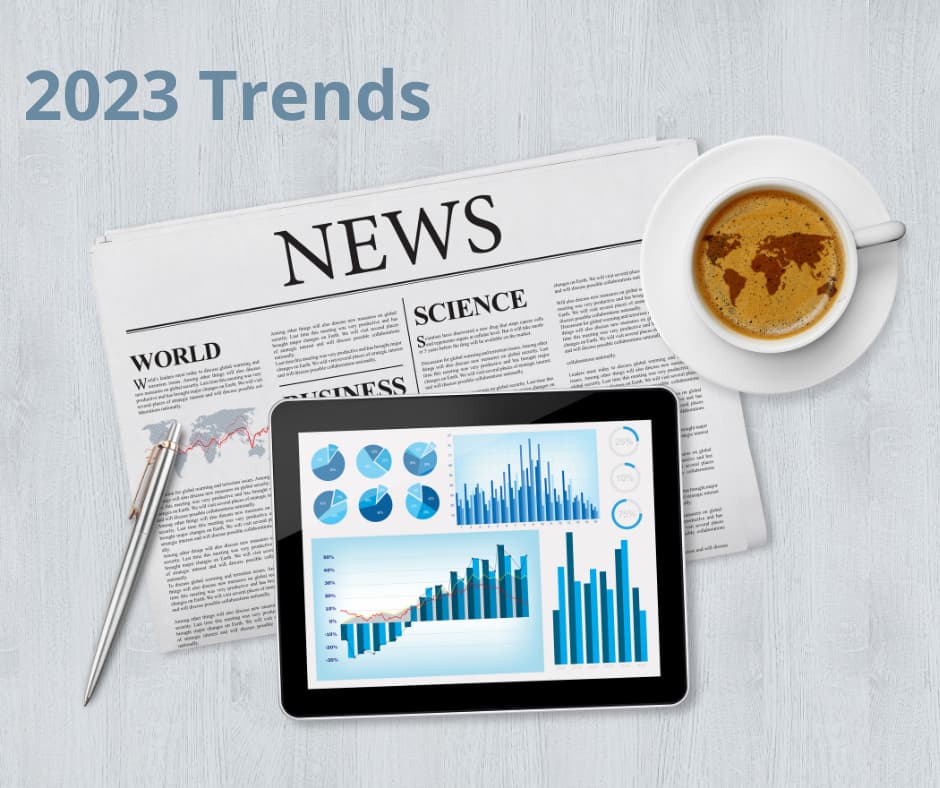The technological environment is rapidly evolving for those involved in the transportation industry ~ manufacturers, distributors and logistics companies. Recognizing trends and taking action in order to incorporate these measures into business practices is practically required in order to maintain a competitive advantage, but the appropriate action may differ from company to company. Below are the important trends to consider when deciding which investments are correct for your firm.
The dominant 2023 trends focus on the adoption of technological advancements for collaboration and improved efficiency, as well as on-going efforts to move industry toward a more sustainable future. However, these advancements come at a cost and continued supply chain disruptions and economic uncertainties may hinder implementation efforts. Here we will summarize some of the emerging transportation and supply chain trends we expect to become more wide-spread throughout 2023.

In a recent edition of Forbes, Steve Banker, the Vice-President of Supply Chain Services at ARC Advisory Group, outlined several key trends in the transportation industry. Mr. Banker’s article focused on emerging and evolving technological advances including:
- Cloud applications to improve communication and information sharing among a network of supply chain partners to create efficient freight movement.
- Growth in Transportation Management Systems (TMS) including the incorporation of artificial intelligence (AI), real-time visibility and the adoption of connected tracking and control devices (the “Internet of Things (IoT)” / telematics).
- Warehouses will incorporate Time Slot Management practices to organize resources and prepare for incoming trucks while reducing time consuming paperwork and streamlining record transfers.
- Autonomous Last Mile Deliveries, where companies use drones and robots for local deliveries, are likely to emerge from test markets into the mainstream.
2023 Trends: Cloud Applications
Transportation industry partners who share data through a cloud application are better prepared for deliveries.Technology brings the various links in the supply chain closer together, and cloud applications facilitate communication among these in-network partners along the length of the entire chain. Sharing information enables optimal route planning, provides additional lead time to shift resources to accommodate delays and schedule changes, and streamlines record requirements and paper transfers so that each company may optimize their personnel and their operations. The more partners using the same cloud application system, the greater the efficiency.
2023 Trends: Blockchain Technology
While not currently in widespread use outside of cryptocurrency exchanges, there is potential for blockchain technology to provide large benefits in the supply chain and transportation sector. Blockchain technology may record, track and verify cargo transactions from the shipper to a manufacturer, manufacturer to distributors, distributor to retail establishments and then to the end user all while providing proof of origin, quality control and other benefits. In addition to providing this unalterable ledger to track products from their origin to destination, the logistics industry is adopting blockchain technology to reduce incidents of fraud, theft, and tampering as well.
2023 Trends: Artificial Intelligence (AI)
Transportation companies are integrating AI to improve employee and customer experiences and to better manage inventory in real time. The rollout of AI is at an early stage and leading platforms still have bugs to work out. But, competing technologies are evolving rapidly and showing strong promise. AI can “learn” about traffic constraints such as bottlenecks or real-time incidents and it can be “taught” regulatory requirements such as hours of service limits. By integrating this data, AI is able to properly plan the most efficient delivery routes and rapidly transition the driver to an alternate route when conditions change. AI also provides more accurate ETA’s for shipments to warehouses, stores, and customers enabling Time Slot Management practices to be more effective.
2023 Trends: Mechanical Automation
Automation is an essential part of warehouse operations and this continues in our 2023 trends. We expect automation to incorporate the use of advanced mechanical technologies such as:
- Automated storage and retrieval systems (ASRS)
- Automated conveyor systems
- Automated guided vehicles and automated mobile robots
- Automated picking arms
While most of these mechanical advances are currently in the use at warehousing and production facilities, we expect to see an even greater and more wide-spread use of robots to counter labor shortages, reduce repetitive manual labor, human errors, and work related injuries. In addition, automated storage and retrieval systems (ASRS) incorporating “smart” tags and allowing real-time transparency for customers tracking their products will become prominent. Customers will come to expect the ability to “see” what inventory is available and where their delivery is in real time.
When combined these components may dramatically increase the speed, efficiency and accuracy of warehousing and deliveries across the country. Gains will be achieved through faster, more accurate order fulfillment and in customer satisfaction.
In addition to automation, regulatory and legislative developments are trending.
2023 Trends: Legislation
The 2022 Infrastructure Investment and Jobs Act (IIJA) and the Inflation Reduction Act accelerated the trend of moving automobiles away from gas power to electric vehicles (EV). Major manufacturers of cars and light duty trucks are shifting production to make more electric and hybrid models available. The National Electric Vehicle Infrastructure program will continue to grow and as Forbes reports, it expects to spend over $1.5 billion constructing EV chargers along an estimated 75,000 miles of highway in the USA and Puerto Rico.
Also, on the horizon is the much debated proposal by the US Securities and Exchange Commission (SEC) requiring public companies to include climate-related disclosures in their annual reports. While there remains uncertainty in the implementation of this proposal, some companies are voluntarily reporting environmental and sustainability impacts and working to achieve corporate sustainability and emissions reduction targets.
In addition, the California Air Resource Board (CARB) has mandated that all new drayage trucks sold in California be electric by 2024. Companies would need to completely retire any diesel or gas-powered drayage trucks by 2035
2023 Trends: Conclusion
Transportation companies balancing simultaneous needs for leaner more agile operations, optimization of talent and labor resources, faster more accurate loading / unloading of deliveries, and an improved customer experience are investing in promising new collaborative technologies. While decision-makers must consider the market outlook and unique financial position of their company, staying current on supply chain trends and taking risks on technology often delivers rewards to early adopters who successfully navigate their implementation.
When growing your supply chain network, include a liquid bulk equipment provider for optimal fleet management and rapid sourcing. Penn Intermodal Leasing, LLC has successfully adapted to transportation and supply chain trends for over 30 years in the chassis leasing business. We provide customers with equipment experience and industry expertise, as well as liquid bulk transportation equipment solutions. If your supply chain network doesn’t include an experienced equipment provider then contact us or call us at 888-909-PENN to discuss how we may be of assistance.
Sources
- Banker, Steve. “Top 5 Transportation Technology Trends for 2023.” Forbes, Forbes Magazine, 19 Dec. 2022. Accessed 26 January 2023.
- Reinblatt, Heather. “9 Logistics Industry Trends and Innovations in 2023.” Circuit, 22 Dec. 2022. Accessed 31 January 203.
- Roston, Eric. “From Emissions to Global Warming, the Climate Numbers to Watch in 2023.” Bloomberg.com, Bloomberg, 3 Jan. 2023,. Accessed 1 February 2023.
- Salo, Rudy. “2023 Transportation Trends That Could Impact the Future of Transportation.” Forbes, Forbes Magazine, 5 Jan. 2023,. Accessed 30 January 2023.

